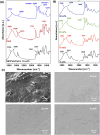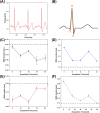Sericin Electrodes with Self-Adhesive Properties for Biosignaling
- PMID: 39904518
- PMCID: PMC12079639
- DOI: 10.1021/acsbiomaterials.4c02234
Sericin Electrodes with Self-Adhesive Properties for Biosignaling
Abstract
The combination of green manufacturing approaches and bioinspired materials is growingly emerging in different scenarios, in particular in medicine, where widespread medical devices (MDs) as commercial electrodes for electrophysiology strongly increase the accumulation of solid waste after use. Electrocardiogram (ECG) electrodes exploit electrolytic gels to allow the high-quality recording of heart signals. Beyond their nonrecyclability/nonrecoverability, gel drying also affects the signal quality upon prolonged monitoring of biopotentials. Moreover, gel composition often causes skin reactions. This study aims to address the above limitation by presenting a composite based on the combination of silk sericin (SS) as a structural material, poly(vinyl alcohol) (PVA) as a robustness enhancer, and CaCl2 as a plasticizer. SS/PVA/CaCl2 formulations, optimized in terms of weight content (wt %) of single constituents, result in a biocompatible, biodegradable "green" material (free from potentially irritating cross-linking agents) that is, above all, self-adhesive on skin. The best formulation, i.e., SS(4 wt %)/PVA(4 wt %)/CaCl2(20 wt %), in terms of long-lasting skin adhesion (favored by calcium-ion coordination in the presence of environmental/skin humidity) and time-stability of electrode impedance, is used to assemble ECG electrodes showing quality trace recording over longer time scales (up to 6 h) than commercial electrodes. ECG recording is performed using customized electronics coupled to an app for data visualization.
Keywords: biocompatible materials; electrocardiography; epidermal electrodes; silk sericin; wearable electronics.
Conflict of interest statement
The authors declare no competing financial interest.
Figures







References
-
- Sousa A. C.; Veiga A.; Maurício A. C.; Lopes M. A.; Santos J. D.; Neto B. Assessment of the Environmental Impacts of Medical Devices: A Review. Environ. Dev. Sustainability 2021, 23 (7), 9641–9666. 10.1007/s10668-020-01086-1. - DOI
-
- Al-Haidari R.; Falola B.; Alhendi M.; Schadt M. J.; Poliks M.; Balder D.; Stemmermann A.; Foster M.; Balchand V.; Kao T. J.; Stoffel N. In Conformal Dry Electrode for ECG Monitoring; Proceedings - Electronic Components and Technology Conference; Institute of Electrical and Electronics Engineers Inc., 2024; pp 1662–1669.
-
- Zalar P.; Saalmink M.; Raiteri D.; van den Brand J.; Smits E. C. P. Screen-Printed Dry Electrodes: Basic Characterization and Benchmarking. Adv. Eng. Mater. 2020, 22 (11), 200071410.1002/adem.202000714. - DOI
-
- Fabiani C.; Pizzichini M.; Spadoni M.; Zeddita G. Treatment of Waste Water from Silk Degumming Processes for Protein Recovery and Water Reuse. Desalination 1996, 105 (1–2), 1–9. 10.1016/0011-9164(96)00050-1. - DOI
MeSH terms
Substances
LinkOut - more resources
Full Text Sources
Research Materials
Miscellaneous
